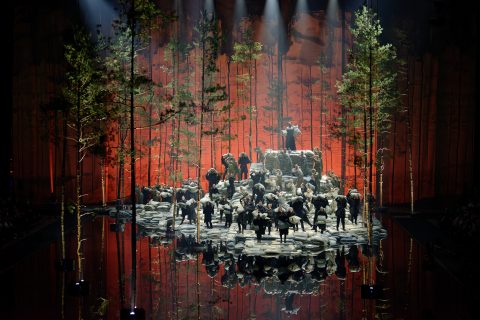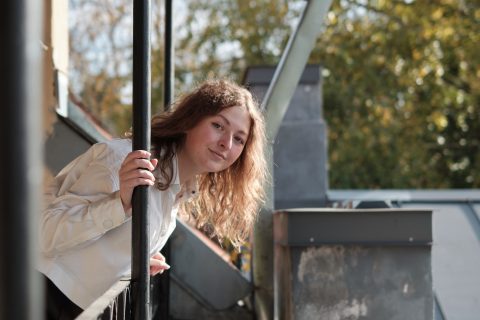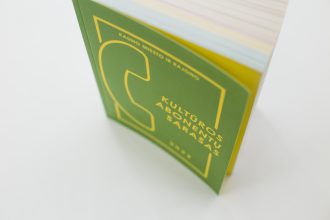“My boss appreciates this extracurricular activity and considers it one of my strengths as an employee,” Mindaugas Šatkus surprises us by informing us that sports are not his main job, but only a hobby. The founder of the movement enthusiasts’ community Šešios trim – found not only in sports but also in cultural circles – appears to be working from “eight to five” as a Sustainability Compliance Manager in one factory. And it was called Šešios trim (en. 6:30 am/pm) precisely because at the very beginning the workout would start at the time, either before or after work.

We met with Kaunas 2022 Ambassador Mindaugas for a walk on the freezing Laisvės Avenue on the fourth anniversary of Šešios trim. We covered about five thousand steps, that is, half the recommended daily amount while talking about the relationship (or unity) between body and mind, sport and culture. If you decide to read the interview while walking, don’t do it on a busy street!
Four years. That is a lot for an initiative, which, I guess, was born quite spontaneously. How did this happen?
What happened was that we, members of the then sports initiative My Hero Kaunas, had no other choice. We would have had to break up because there were only two of us left in Kaunas. The team was commuting from Vilnius and could not dedicate us much time. To sum up, this is how Šešios trim came to be.
Now there are six of us. Four very active trainers, including me (the fifth one is not so active at the moment), as well as Arūnas Gurskas, a shareholder of the project. It would have been difficult to start without his help because we needed capital for the facilities, practical things.
And how many followers are there? Is it possible to count them when you have been working out virtually for some time?
Numbers are a slippery thing. When you look at how many views the workout sessions get on Facebook, it looks a lot. We have over 6,000 unique followers. And we haven’t paid for a single click, we haven’t chased consumers and it seems like a big thing to me. Of course, we celebrate every thousand new followers with exercise. We come up with what number of repetitions to perform.
Why do you think people join such initiatives like Šešios trim? is it because they want to change something in their life or to fill a void? What other reasons are there?
I would add people who want to be in the epicenter of the movement, to be part of it, be cool. Whatever it is, it’s good, all the reasons are valid. Some come to us because they are tired of gyms. There is no competition here, no fashion shows, or looking for gain. It doesn’t matter if you work at the cash register or run a company. In the gym, everyone is the same and united. Others, of course, come to find themselves or even collect themselves. During a conversation on Ignas Šalnaitis’ podcast, he said something good, “Šešios trim is like an emergency exit.” I personally had various affairs and hobbies as well as psychological downs. I understand those who come to survive love tragedies, losses, addictions. Sometimes you don’t even know it, and only after some time, a person tells you about it, after they already solved their problems. It kind of motivates you to move forward. After all, I also have existential thoughts, like, why am I doing all this?
Where is that difference between sports and physical culture?
At school, there was “physical education”, which then became “physical culture”, right? And on a more serious note, I think that movement makes people happier. This is physiology, this is how the so-called happiness molecules are born. And then it all turns into that other, more traditionally understood culture. For example, the Šešios trim community goes to exercise to a museum, a fort, a theatre. And then the same person who was jogging in the theatre – which is quite peculiar – returns to watch a play. They return with a memory of having a good time at the theatre. Such coincidences occur inadvertently but I personally find this connection and exchange between physical and spiritual culture, very organic. Also, members of our community include people working in cultural or academic institutions and they bring in a different perspective. I learn from every conversation, every experience. I grow richer as a person while being here.
Do you ever experience burnout?
Of course. And you understand this only when the results, mood, or desire to engage in sports declines. But otherwise, you can’t know your limit. And everyone has limits. The physical state I am in now, I mean… it has never happened before that I would exercise this much. In terms of fitness, quarantine is beneficial. But would I advise everyone to do that? Does everyone need it? I don’t think so. You need to find your own way.
I think I heard about you for the first time in the context of Gediminaičiai Run and other similar marathons. That is when you run a phrase or a number on the map. What was the longest word you ran? Was it “nebeprisikiškiakopūsteliaudavusiems”?
No, it was “žalgiris.” The previous one would have been difficult to achieve in Kaunas. In New York or Chicago, where the streets intersect at right angles, it would be easy because you don’t have to do that many kilometers.
In Barcelona, for example, Žalgiris took me 31 km, and in Kaunas 18 km. Here we started from the P. Vileišis Bridge over the Neris, ran in various angles, riverbanks, across streets… On Šv. Gertrūdos Street we discovered a very beautiful 19th-century house, the yard of which we crossed. Maybe I, as a Kaunas resident, did not discover many new things on this route but, for example, students coming from other cities were very interested in such “tourism.”
Usually, when you run for the first time, you draw a route on a tourist map. Now, of course, you can already do it on your computer, upload it to your watch, and the technology will tell you the rest.
Technology is a good topic as well. When do you run better, with music or without? With apps or without them?
It all depends on what the goal is. If you just want to jog, have a good time, then, of course, there is no need for apps. But if you’re results-oriented then it really helps. Before I used to just run without apps. The only thing I couldn’t do without was music, it was a necessary attribute. And now, I cannot remember the last time I ran with music. I just came to the realization that when you live in constant noise, going into peace, quiet, forest or night becomes of great value. I could not think of a better leisure time.
Now, let’s go back to Žalgiris. Often, or maybe even always, you can be seen tensely drumming in a fan section of any home game. You also participate in team presentations. Even now, when the players are supported only by cardboard cutout fans, you are among them. Have you been a Žalgiris fan for a long time?
Very long… I am a member of the Green Death fan club. Green White Boys is a younger club. They even get angry with us that we don’t sing along with them, that we are calmer. Although I am certainly not one of those more passive ones. And I inherited the drum from other members of Green Death club, it’s a pioneer-like drum, about thirty years old. And it has a name: Akela. With a drawing of a wolf (Akela was a character in Rudyard Kipling’s Jungle Book, ed.). I think I have been beating the drum for around a decade, since the days of Sports Hall. I also renovated it myself.
Recently we talked about how angry people don’t jump into ice holes. But sometimes, the true sports fans seem really angry. After all, one does need anger to beat the drum well, no?
I both love that team and get angry at it at the same time. You could say I work in the arena, I beat the drum, but I also hear many things around me. When I watch the game on TV, of course, I turn into one of those three million coaches… I have so much advice to give. When you’re watching and can’t do anything (by the way, I was not a good basketball player, maybe would be better now) of course, you get angry, you swear but it’s a momentary emotion. Real fans, who live and breathe Žalgiris, will never feel hatred. Unless they are glory hunters…
And where is the line between healthy fanaticism and being an ultra, when the fans of the opposing team get into real danger?
Well, I’m not an ultra myself. I don’t understand that approach and that movement. What do you need to protect the colors of your club from? Missing the war much [laughs]? I think when a different color becomes bad and you start hating a person for supporting a different team, then it’s already an extreme, some psychological thing.
Finally, let’s talk about trends. Before, those who would go to clubs on Fridays are now meeting in ice holes on Saturday mornings. What do you think about these challenge trends?
“Trend” is a good word. Yes, there are people who chase trends. There are those who have been doing it for years and the ones who have just discovered it. The effects of cold water are good, adrenaline causes the brain to calm down, to pause in the here and now, as the yogis say. It is difficult for us busy people to understand that here and now concept. In the ice hole that understanding reaches you inevitably. Such ways of shocking the body are also a part of communication and culture. After all, you can’t be an angry person if you’re going into the ice hole.
Of course, this year there are definitely more people doing this. And, I would say, more on an individual basis, which, of course, is a consequence of quarantine restrictions. In the past, maybe we gathered more in groups on the weekends. Now some have more time on the weekdays as well. That’s fine, they should try their strength, and should become better!




